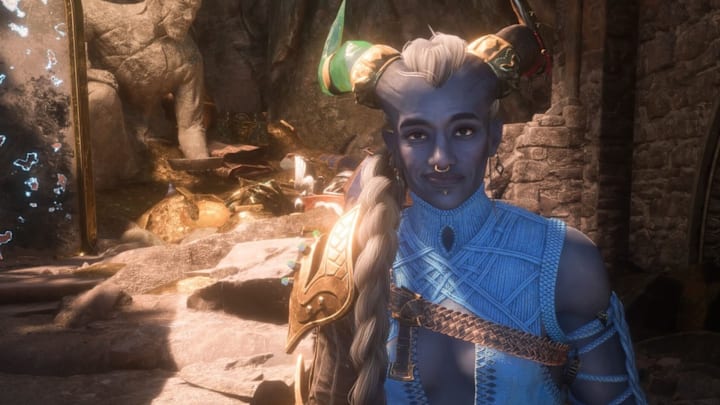Dragon Age: The Veilguard is the first triple-A game to handle gender identity the right way

Warning: this article contains spoilers for Dragon Age: The Veilguard. If you want to go in totally blind, click away now.
Dragon Age: The Veilguard opens with the most inclusive character creator I’ve ever seen. In addition to the millions of regular possible permutations for your player character, Rook, there are options for creating a nonbinary or trans character. The Veilguard gives you options for top surgery scars, they/them pronouns, and various sliders to alter your body exactly the way you want it. Bulges, butts, breasts, and more are all finely tunable, and their inclusion is just one part of many ways in which the game handles gender identity better than any other triple-A game to date.
Trans and nonbinary characters get additional conversation options where appropriate, too, offering insight from the lived experiences of a gender diverse person in situations that feel genuine and well-executed. This isn’t a character inserting their identity in every conversation, it’s only where it makes sense, and it’s always handled with a shocking amount of elegance for a triple-A game. These additional choices most come into play when working through the personal questline of Taash, the Veilguard’s resident Qunari dragon-slayer.
Taash is a character torn between two different worlds. Born of a strict, faithful Qunari mother and brought to Rivain at a young age, the noble dragon hunter doesn’t quite feel Rivainian, and doesn’t quite feel Qunari. After years spent isolated from most of society, in part due to the rare ability to breathe fire, Taash comes into the Veilguard when the team is in need of a dragon hunter, and not long after, a realization hits: Taash doesn’t feel like a woman, and doesn’t feel like a man. A few chats with the team, and that feeling is matched with a word — Taash is nonbinary.
The rest of Taash’s story is a mixture of dragon-hunting and Qunari secrets being unveiled, but the underlying throughline is their grappling with this realization. We see Taash worrying about how being nonbinary interacts with their twin cultures, what words to use for themself, and what the team thinks of it all. Most of all, though, they worry about how their mom is going to take it.
Scattered throughout the game are notes written by Taash as they grapple with all of this. A visit to other trans and nonbinary characters in the game – of which there are quite a few – sees Taash taking notes as those characters explain what it means to be trans and nonbinary. It’s a concept largely foreign to Qunari and Rivainian culture and faith, and even when they know how they feel inside, there’s still a lot to learn. That note ends on a touching finish, where another character assures them that what they feel is valid, no matter what anybody else thinks, and no matter when they learned the words to describe that feeling.
It’s a note that brought a tear to my eye, because I’ve been in Taash’s position. I have a complicated relationship with gender, too, and when I finally learned how to describe that feeling, it was a huge weight lifted off my shoulders. But it also made life much more complicated — I had so much to learn, so much to process, and a lot of questions that I couldn’t answer alone. It was my friends and loved ones that helped me through that, and in The Veilguard, Taash’s friends and loved ones do the same for them. It’s authentic, and messy, and raw, and there’s no doubt in my mind that it was written by a nonbinary person.
Another note shows Taash drafting a speech to tell their strict, religious mom that they’re nonbinary. They walk through a dozen possibilities, dismissing each one as something that just wouldn’t get through. At the bottom of the page, they settle on a direct approach:
“I’m nonbinary. It means I am not a man or a woman. I use ‘they’ instead of ‘she’ now.”
I won’t spoil exactly how that conversation eventually goes, but it’s a powerful, heartbreaking moment that many queer people will recognize and sympathize with. It’s one of many throughout Taash’s story, and the ability to interject as a person with lived trans or nonbinary experience, to offer advice and guidance, is a nice touch. You get to be the elder queer that every young queer person hopes for, offering a path forward when nothing makes sense on the inside.
It’s a story with the best intentions, told well and without restraint, something that’s exceedingly rare for a triple-A game. BioWare has touched on queer stories in the past, even within the Dragon Age series – Dorian’s personal struggles as a gay man in Inquisition come to mind – but The Veilguard goes one step further, unashamedly and unabashedly calling one of its most compelling characters nonbinary and following through with a story that isn’t afraid to pull its punches.
That’s not to say that The Veilguard handles everything in the LGBTQ+ spectrum perfectly, though. Having every romanceable character romanceable by a player of any gender expression – playersexual, as often named by players – is a small step back from Inquisition and its predecessors. A story like Dorian’s couldn’t be told in The Veilguard, and while Taash’s story is more than a suitable alternative, it’s a little bit of a bummer that not a single romanceable character in the game is explicitly gay or lesbian. They’re just whatever you want them to be.
But that’s not entirely BioWare’s fault, either. When your character creator allows such depth when it comes to gender identity, you have to ask a lot of thorny questions about how to handle sexuality. Would it make sense for a gay man to fall in love with a feminine-presenting nonbinary person? It happens all the time in real life, but making every gay character attracted to every nonbinary character would feel a bit cheap in a game like this. The result is an inelegant solution to a good problem to have — The Veilguard is so good at representing gender identity that it can’t do everything else perfectly.
But with how well Taash is handled throughout the game, and the options afforded to players to represent their identities in-game, any minor nitpicks fall by the wayside. After decades of triple-A game development, Dragon Age: The Veilguard is the first to finally get gender identity right, and that’s a solid win if nothing else.
